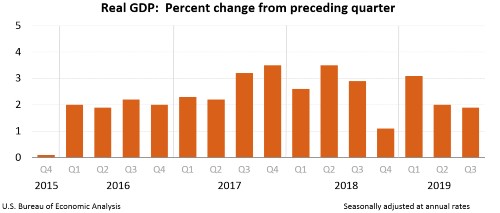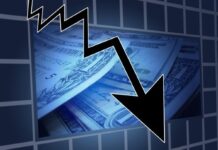U.S real gross domestic product (GDP) increased at an annual rate of 1.9 percent in the third quarter of 2019, according to the “advance” estimate released by the Bureau of Economic Analysis.
In the second quarter, U.S real GDP increased 2.0 percent. The “second” estimate for the third quarter, based on more complete data, will be released on November 27, 2019.

”The increase in real GDP in the third quarter reflected positive contributions from personal consumption expenditures (PCE), federal government spending, residential fixed investment, state and local government spending, and exports that were partly offset by negative contributions from nonresidential fixed investment and private inventory investment. Imports, which are a subtraction in the calculation of GDP, increased” said in the statement.
”The deceleration in real GDP in the third quarter reflected decelerations in PCE, federal government spending, and state and local government spending, and a larger decrease in nonresidential fixed investment. These movements were partly offset by a smaller decrease in private inventory investment, and upturns in exports and in residential fixed investment.”
READ ALSO : U.S economy grows 3.2% YoY in first quarter of 2019
Current dollar GDP increased 3.5 percent, or $185.6 billion, in the third quarter to a level of $21.53 trillion. In the second quarter, GDP increased 4.7 percent, or $241.4 billion.
The price index for gross domestic purchases increased 1.4 percent in the third quarter, compared with an increase of 2.2 percent in the second quarter. The PCE price index increased 1.5 percent, compared with an increase of 2.4 percent. Excluding food and energy prices, the PCE price index increased 2.2 percent, compared with an increase of 1.9 percent.
Current-dollar personal income increased $172.8 billion in the third quarter, compared with an increase of $244.2 billion in the second quarter. The deceleration reflected a downturn in personal income receipts on assets and decelerations in compensation and in personal current transfer receipts that were partly offset by an acceleration in proprietors’ income.
Disposable personal income increased $181.7 billion, or 4.5 percent, in the third quarter, compared with an increase of $192.6 billion, or 4.8 percent, in the second quarter. Real disposable personal income increased 2.9 percent, compared with an increase of 2.4 percent.
Personal saving was $1.34 trillion in the third quarter, compared with $1.32 trillion in the second quarter. The personal saving rate — personal saving as a percentage of disposable personal income — was 8.1 percent in the third quarter, compared with 8.0 percent in the second quarter.





















